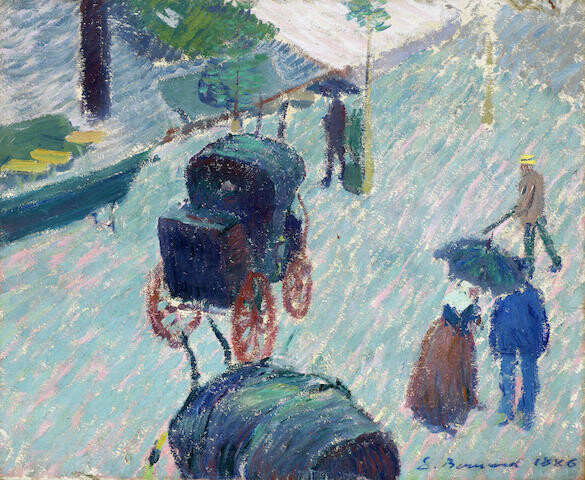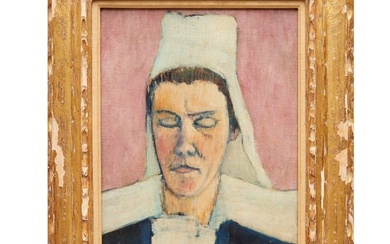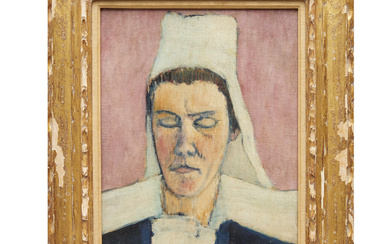Émile Bernard, (French, 1868-1941)
Le jardin public à Mayenne
Le jardin public à Mayenne
signed and dated 'E. Bernard 1886' (lower right)
oil on canvas
38.1 x 46.2cm (15 x 18 3/16in).
Painted in 1886
This work will be included in the critical catalogue of the work of Emile Bernard currently being prepared by the Wildenstein Institute.
Provenance
Ambroise Vollard Collection, Paris.
Robert de Galéa Collection, Paris (by descent from the above).
Marquis de Bollin Collection, Paris.
Galerie Nicole Bertagna, Paris.
Josefowitz Collection, Europe (acquired from the above, June 1957).
Anon. sale, Christie's, Paris, 23 May 2007, lot 56.
Acquired at the above sale by the present owner.
Exhibited
Los Angeles, County Museum of Art, Monet to Matisse: a Century of Art in France from Southern California Collections, 9 June 11 August 1991.
Literature
J.-J Luthi, Emile Bernard, catalogue raisonné de l'oeuvre peint, Paris, 1982, p. 6, no. 25 (illustrated).
J.-J Luthi & A. Israël, Emile Bernard, Instigateur de l'Ecole de Pont-Aven, précurseur de l'Art Moderne Sa vie, son oeuvre, catalogue raisonné, Paris, 2014, p. 140, no. 20 (illustrated).
The pilgrimage from Paris to Brittany that Emile Bernard made in 1886 was a fateful moment in the development of Post-Impressionist Art. In Pont-Aven, at the end of his long journey on foot, Paul Gauguin awaited him: together Bernard and Gauguin would change the course of art and create the Synthetist movement which brought them both great renown. Alongside them were painters such as Schuffenecker, Anquetin, Sérusier, de Haan and Laval. This small group of avant-garde artists gathered in Brittany in the mid-to-late 1880s after rejecting the academic strictures of the Paris art schools. Bernard himself had actually been thrown out of the Atelier Cormon in Paris after he vocally criticised the teaching there.
Bernard joined the atelier in 1881, at a time when both Louis Anquetin and Henri de Toulouse-Lautrec were studying there under Cormon. Together the three artists discovered the world of Montmartre's clubs and bars, developing their own style and artistic practices. Bernard was at first, like so many of his contemporaries, drawn to the work of the Impressionists, who had been exhibiting in Paris throughout the 1870s and early 1880s. Bernard was ultimately left unsatisfied after experimenting with Impressionism and Pointillism. Along with Anquetin and Van Gogh whom he met in 1886 at Cormon's atelier he developed an interest in Japanese print-making that helped him develop a new synthetic style characterised by bold, flat use of colours and clearly delineated motifs outlined in black. This new style, that would go on to be a hallmark of the Pont-Aven school, was really developed by Bernard on his crucial trip to Brittany.
Le jardin public à Mayenne was painted in 1886 during this journey, most likely en route from Paris to Pont-Aven. One can see the bridge between the Pointillism of Signac and Seurat (with which Bernard had already toyed) and the Synthetism that he would develop during the five months spent at his destination. Perspective is almost absent, with the viewer being shown a snapshot of the street in Mayenne with one carriage abruptly cut off. This jarring framework would find powerful use in the works of Gauguin and Bernard such as the pivotal Vision of the Sermon of 1888, where the framing of Gauguin's work cuts straight through the group of Breton women praying in their bonnets. This novel compositional device can be seen both as a product of Bernard's exposure to Japanese prints, but also of the new technique of photography, whose influence could be felt more and more in the contemporary art of the day.
The present work perfectly demonstrates the artist's love of vivid colour that marked this new phase in his career, with the striking blues, greens, reds and a stirring flash of yellow. Bernard had not yet developed the delineated cloisonné style that he would pioneer during this period, and as such the work still refers to his experiments in Pointillism. The subject matter remains essentially urban, modern and rooted in reality the coaches pass by, couples cross the street and the day-to-day life of the town of Mayenne continues as it always had. In showing this slice of modern life, Bernard relates his work back to the boulevards of Paris and his exploration of the modern city whilst a member of the Atelier Cormon. Once he had arrived in Pont-Aven however, he found inspiration in the timeless costumes of the Breton peasants and farmers, and sought to find magic and spirituality in the motifs he discovered there.
View it on
Estimate
Time, Location
Auction House
Le jardin public à Mayenne
Le jardin public à Mayenne
signed and dated 'E. Bernard 1886' (lower right)
oil on canvas
38.1 x 46.2cm (15 x 18 3/16in).
Painted in 1886
This work will be included in the critical catalogue of the work of Emile Bernard currently being prepared by the Wildenstein Institute.
Provenance
Ambroise Vollard Collection, Paris.
Robert de Galéa Collection, Paris (by descent from the above).
Marquis de Bollin Collection, Paris.
Galerie Nicole Bertagna, Paris.
Josefowitz Collection, Europe (acquired from the above, June 1957).
Anon. sale, Christie's, Paris, 23 May 2007, lot 56.
Acquired at the above sale by the present owner.
Exhibited
Los Angeles, County Museum of Art, Monet to Matisse: a Century of Art in France from Southern California Collections, 9 June 11 August 1991.
Literature
J.-J Luthi, Emile Bernard, catalogue raisonné de l'oeuvre peint, Paris, 1982, p. 6, no. 25 (illustrated).
J.-J Luthi & A. Israël, Emile Bernard, Instigateur de l'Ecole de Pont-Aven, précurseur de l'Art Moderne Sa vie, son oeuvre, catalogue raisonné, Paris, 2014, p. 140, no. 20 (illustrated).
The pilgrimage from Paris to Brittany that Emile Bernard made in 1886 was a fateful moment in the development of Post-Impressionist Art. In Pont-Aven, at the end of his long journey on foot, Paul Gauguin awaited him: together Bernard and Gauguin would change the course of art and create the Synthetist movement which brought them both great renown. Alongside them were painters such as Schuffenecker, Anquetin, Sérusier, de Haan and Laval. This small group of avant-garde artists gathered in Brittany in the mid-to-late 1880s after rejecting the academic strictures of the Paris art schools. Bernard himself had actually been thrown out of the Atelier Cormon in Paris after he vocally criticised the teaching there.
Bernard joined the atelier in 1881, at a time when both Louis Anquetin and Henri de Toulouse-Lautrec were studying there under Cormon. Together the three artists discovered the world of Montmartre's clubs and bars, developing their own style and artistic practices. Bernard was at first, like so many of his contemporaries, drawn to the work of the Impressionists, who had been exhibiting in Paris throughout the 1870s and early 1880s. Bernard was ultimately left unsatisfied after experimenting with Impressionism and Pointillism. Along with Anquetin and Van Gogh whom he met in 1886 at Cormon's atelier he developed an interest in Japanese print-making that helped him develop a new synthetic style characterised by bold, flat use of colours and clearly delineated motifs outlined in black. This new style, that would go on to be a hallmark of the Pont-Aven school, was really developed by Bernard on his crucial trip to Brittany.
Le jardin public à Mayenne was painted in 1886 during this journey, most likely en route from Paris to Pont-Aven. One can see the bridge between the Pointillism of Signac and Seurat (with which Bernard had already toyed) and the Synthetism that he would develop during the five months spent at his destination. Perspective is almost absent, with the viewer being shown a snapshot of the street in Mayenne with one carriage abruptly cut off. This jarring framework would find powerful use in the works of Gauguin and Bernard such as the pivotal Vision of the Sermon of 1888, where the framing of Gauguin's work cuts straight through the group of Breton women praying in their bonnets. This novel compositional device can be seen both as a product of Bernard's exposure to Japanese prints, but also of the new technique of photography, whose influence could be felt more and more in the contemporary art of the day.
The present work perfectly demonstrates the artist's love of vivid colour that marked this new phase in his career, with the striking blues, greens, reds and a stirring flash of yellow. Bernard had not yet developed the delineated cloisonné style that he would pioneer during this period, and as such the work still refers to his experiments in Pointillism. The subject matter remains essentially urban, modern and rooted in reality the coaches pass by, couples cross the street and the day-to-day life of the town of Mayenne continues as it always had. In showing this slice of modern life, Bernard relates his work back to the boulevards of Paris and his exploration of the modern city whilst a member of the Atelier Cormon. Once he had arrived in Pont-Aven however, he found inspiration in the timeless costumes of the Breton peasants and farmers, and sought to find magic and spirituality in the motifs he discovered there.





